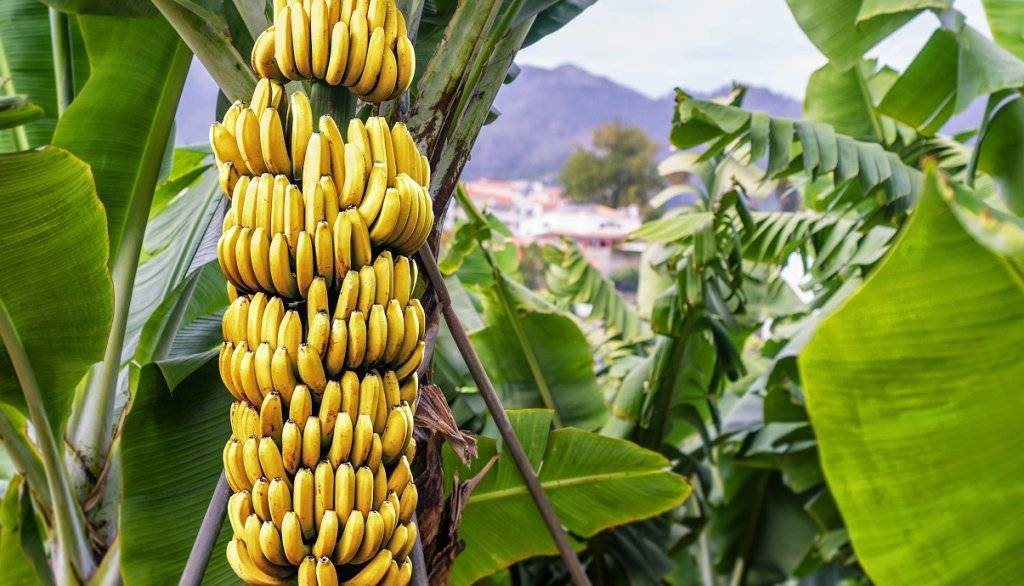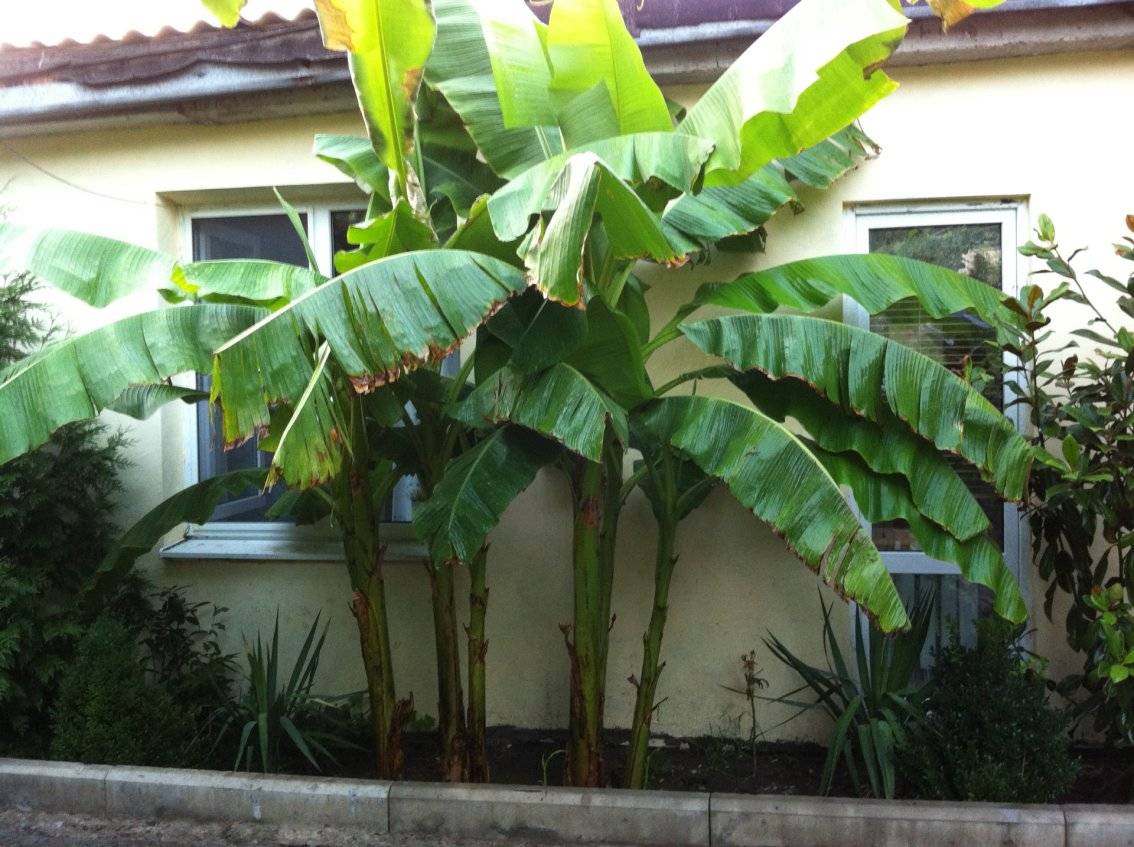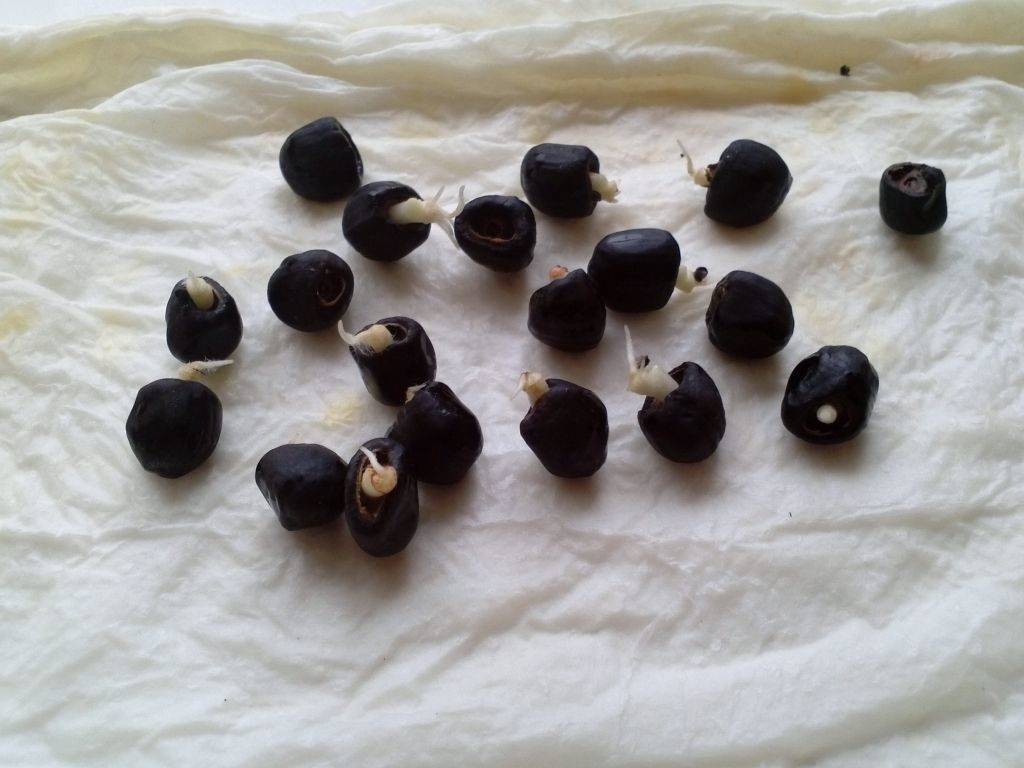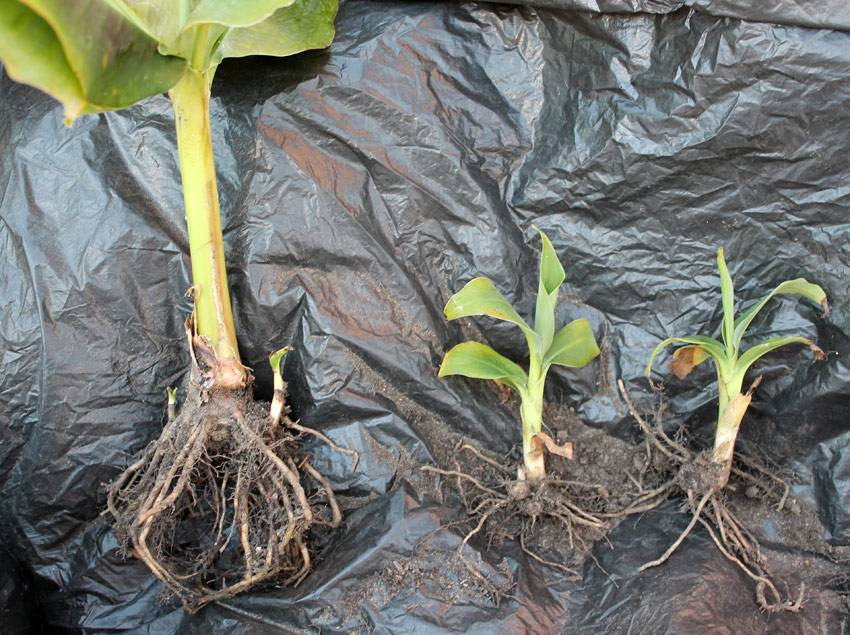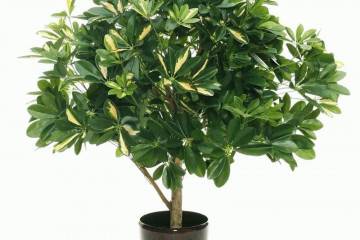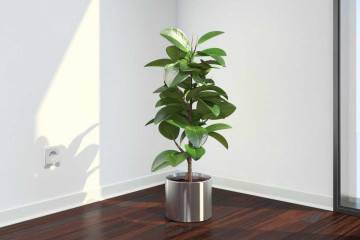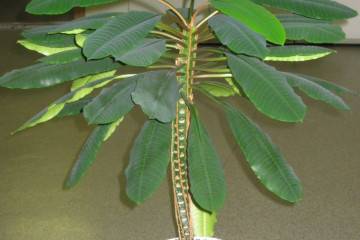Indoor banana (banana palm) - home care
Content:
- What does an indoor banana look like, which family does it belong to?
- Features of caring for a banana indoor home
- How to grow outdoors, where and under what conditions it is possible
- When and how it blooms
- How to propagate indoor banana
- Transplant: when it is necessary, how to carry it out correctly
- Possible problems in growing indoor banana
Only a few decades ago, a banana was an outlandish rarity on domestic counters, and now it has become as common as apples. Perhaps soon it will become as familiar as a houseplant like geranium.
What does an indoor banana look like, which family does it belong to?
A narrow and short trunk with long and wide leaves at its top, under which huge bunches of yellow curved fruits hang - who does not know what a banana looks like!
Description of the plant
Not so long ago, this exotic plant began to grow at home. The goals here can be different: the appearance of the banana palm can impress anyone, and the edible fruit can be a great addition to the table.
There are several dozen varieties of indoor banana. There is no need to memorize them all. It is enough to know that two main types of home exotic are known:
- Dessert - with the help of selection, varieties were bred with smaller sizes than those of its tropical counterparts, but bearing the same tasty fruits.
- Ornamental - the fruits are inedible, the plant is grown exclusively for its appearance or beautiful flowers.
Banana palm is a tree or grass
In fact, it is grass, albeit large. Its short and wide stem sits underground, and what is usually mistaken for a stem is actually banana leaves wrapped in one another.
Beneficial features
The main property of bananas, due to which it has become so widespread throughout the world, is its high calorie content. According to this indicator, it overtakes even potatoes.
Banana is recommended for the diet of ulcers, as a natural and mild laxative for the elderly. This berry is also a source of antioxidants, so its use is an excellent prevention of cancer. Banana contains vitamins and minerals that are necessary for the human body.
Briefly about the history of appearance as a houseplant
Initially, the banana grew only in tropical countries. However, the British, who really wanted to get a piece of the rainforest in their living rooms, created special varieties of banana trees suitable for growing as home plants. It was they who invented the varieties Cavendish Dwarf, Cavendish Superdwarf, Velvet banana and others. Already in the 20th century, other varieties were bred by enthusiasts from different countries.
Features of caring for a banana indoor home
The banana has a very large leaf area that actively interacts with the environment. Therefore, the main tactic when handling it is a lot of heat, light and water.
Temperature
Although the banana is a house plant, it is still native to the tropics and should not be forgotten. The optimum temperature for its growth is 25 - 30 ° C. In winter, this figure can be lowered to 16 ° C, but do not experiment with this.
Lighting
A banana needs a lot of light. It is best if the place in the apartment for him will be illuminated for most of the day. If this is not found, you can always get out of this situation by setting up artificial lighting for the plant.
Watering
There are several rules to follow here:
- Watering can only be done after the soil has dried 2 centimeters deep after the previous watering.
- You need to use a lot of water, but you don't need to overdo it either: the soil can acidify.
- Water for irrigation should be warm and settled.
Spraying
Banana loves moisture, so it is sprayed with a spray bottle every day. In winter, you need to reduce the frequency to 1 time per week.
Humidity
In addition to spraying, the air humidity in the room can be adjusted in other ways: put a container with water or wet expanded clay near the plant, turn on a humidifier.
Priming
Fortunately, indoor banana does not require any special soil composition for home care. It will grow well on the same soil as ordinary ornamental plants. The only condition is that it must be loose enough to ensure good gas and water exchange. However, in this matter, the tree can be helped a little: weekly loosen the soil with a small blunt stick.
Top dressing
Fertilizers should be applied every week, preferably after watering. During the period of a decrease in active growth (in autumn and winter), top dressing should be excluded.
How to grow outdoors, where and under what conditions it is possible
As mentioned, the banana grows primarily in the tropics. In Russia, it grows south of Sochi, but does not bear fruit due to the harsh winter. There is a frost-resistant variety of banana palm, planting and caring for which in the open field does not require large costs. The name of this variety is Japanese banana.
This banana should be planted outdoors in a sunny area, protected from winds that can fray the delicate leaves.
Watering is daily, excluding, of course, rains. Do not forget about humidity, so sprinkling can be used on hot days. To keep the soil moisture longer, mulching will not be superfluous.
When the growing season is over and the leaves fall off, it is necessary to cover the stem for the winter and sprinkle it with earth. As such, it can withstand frosts down to -25 ° C.
When and how it blooms
When the plant is a couple of years old, and the number of leaves reaches 16-18 pieces, it will begin to bloom.
Banana blooms for several months, up to a year. It all starts with a slight thickening at the top of the stem. Then a red bud appears in the central outlet. It grows actively, emerging from the stem on a long peduncle, and eventually reaches the floor. In fact, this is not a flower, but only a container for many inflorescences inside it. They are arranged in layers, separated from each other by the petals of the bud.
First, the lower petals open and bend upward, and the flowers begin to bloom and bear fruit. Then comes the next layer and so on. As already mentioned, this process can take a whole year.
How to propagate indoor banana
The indoor banana tree propagates in two main ways: using seeds (in this case, you should not rely on edible fruits) and vegetatively.
Germinating seeds
The seeds can be purchased from the store or ordered online. Their shells are hard and it will be difficult for the sprout to break through. To make it easier for him this path, it is necessary to violate its integrity: with sandpaper or a file. It is important not to overdo it, a couple of scratches will be enough.
Now you need to place the seeds in warm water, which is changed every 6 hours. After a few days, they will germinate, after which they are transplanted into the ground. To do this, you need to take a container with a lid or buy a special mini-greenhouse. The seeds are not covered with earth, but only pressed into the surface. The soil should be moistened all the time, and the temperature should not be lower than +25 ° C.
Children
The rhizome of a banana is called a rhizome. Periodically, it gives off shoots that are a miniature copy of the parent plant, but associated with a common root system.
To propagate a banana vegetatively, a shoot with several leaves is selected, cut off from the main plant and transplanted into a separate pot. "Baby" will not require separate care.
other methods
When transplanting a banana, it can also be divided into several parts, each of which will have rhizome and leaves. In this way, several copies of the banana will appear.
Transplant: when it is necessary, how to carry it out correctly
The indoor banana flower is an actively growing plant that reaches a size of 2.5 meters in a couple of years. Therefore, it will have to be transplanted often, on average every six months or a year. Do not take too large a container - this can lead to acidification of the soil. Best of all, if it is several centimeters larger than the previous one.
Possible problems in growing indoor banana
Banana is a fairly hardy plant and is not afraid of most diseases. True, it is also not insured against insect pests, but a variety of insecticides can be useful here.
Drops the leaves
The old banana stem, along with the leaves, dies off after each fruiting, and this is a completely normal process. The main thing is that young shoots are actively developing at the same time.
The tips of the leaves dry
Drying of the leaves indicates insufficient air humidity. Place a container of water next to it and spray the plant. This phenomenon is most often observed in winter, when central heating dries up the air.
Pests
The most dangerous parasite for a banana is the hookworm. This worm can lead to root rot and plant death. In this case, you should transplant it into a new pot with a complete replacement of the soil.
Other problems
Dark spots on banana leaves indicate too much watering. If the plant has stopped growing, then this means that it has become cramped, and it needs a new pot.
The banana tree is still exotic as a houseplant. But you shouldn't be afraid of it. In addition to its unusual appearance, its edible varieties are able to bring not only aesthetic, but also gastronomic delight. And the absurdity of the question "a banana is a tree or a bush" will cause an indulgent smile from the owner of a home exotic.

